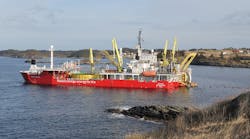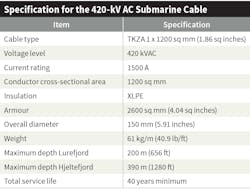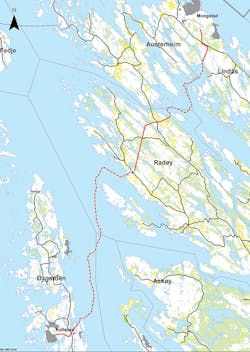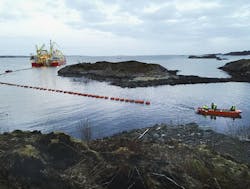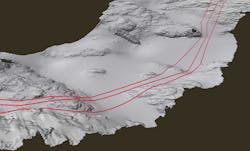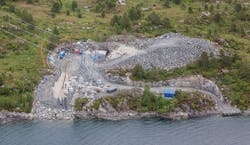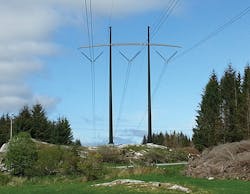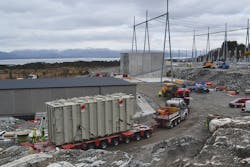Distribution system operator BKK Nett AS is engaged in one of the largest-ever projects to provide essential reinforcement of the transmission system supplying the Bergen region of Norway. Increasing demand in the city and surrounding industrial districts, including oil and gas facilities at Mongstad and Kollsnes, exceeded the load-transfer capacity of the existing infrastructure.
To restore firm capacity and security of supply, BKK Nett AS constructed a new 420-kV AC overhead line and submarine cable circuit between Mongstad in Lindås and oil and gas facilities in the region in Øygarden. A lack of full N-1 redundancy in the supply to oil and gas facilities was the main reason the utility initiated this project, and the cost of a possible outage helped the utility to justify its investments. In addition to improving supply to the industrial facilities at Kollsnes and Mongstad, the new line and circuit provides capacity to supply the ongoing electrification of new offshore platforms in the North Sea.
Bergen Transmission System
Together with the ongoing power link project between Mongstad and Modalen, the Kollsnes–Mongstad link completes the main grid in the Bergen region, forming an outer ring and strengthening the connection to the national main grid. This was a necessary addition to the recently constructed 420-kV overhead transmission line erected between Sima and Samnanger. Completing the Modalen–Mongstad–Kollsnes power link will improve power supply significantly to the whole Bergen region, including the gas terminal at Kollsnes and the oil refinery at Mongstad.
In case of outages on or reduced capacity to the existing network between Bergen and the national main grid, the new 420-kV power link represents a giant leap forward compared to the previous power link, which included more than 60 km (37 miles) of an aging 132-kV overhead line. The new link also increases the grid capacity available for power transport from areas with a surplus of power production to the area in and around Bergen, where most of the consumption is located.
Mongstad–Kollsnes Interconnector
The 420-kV AC Mongstad–Kollsnes circuit comprises three single-core submarine cables and an overhead line installed on a route that includes crossing two fjords, Hjeltefjorden and Lurefjorden. Submarine cables are the major part of this 43.5-km (27-mile) circuit with fjord crossings of 22 km (13.7 miles) and 9 km (5.6 miles). The 12.5-km (7.8-mile) overhead line was constructed in three sections:
• 4 km (2.5 miles) in Lindås
• 6 km (3.7 miles) in Radøy
• 2.5 km (1.6 miles) in Øygarden.
Cable terminations connect the submarine cable to the overhead lines at each landfall.
The two lengths of three single-core submarine cables were installed in the Hjeltefjorden and Lurefjorden fjords, north of Bergen. In Hjeltefjorden, the cable route is more than 22 km long and was installed at a depth of 390 m (1280 ft). The length and depth of this cable installation were world records for a 420-kV AC cross-linked polyethylene (XLPE) submarine cable.
Cable Selection and Seabed Survey
BKK Nett AS selected 420-kV AC XLPE cables because they are equivalent to other extra-high-voltage cable designs in terms of mechanical strength, current-carrying capacity and overall cost, but they have significantly lower maintenance requirements, which the utility felt was the most important advantage. XLPE cables have an overall lower life-span cost and are easier to install than conventional paper-insulated cables. Fluid-filled cables require frequent maintenance and pose an environmental risk in the event of an oil leak. Lower electrical losses as well as the reduced need for reactive power compensation were also important factors taken into consideration.
As part of the utility’s work to reduce uncertainty and have a good basis for the call for bids on its high-voltage sea cable, the utility conducted a comprehensive survey of the seabed with a resolution of 20 cm by 20 cm (7.9 inches by 7.9 inches). Several alternative routes in Lurefjorden and Hjeltefjorden were surveyed. The call for bids included more than 2 TB of electronic bathymetrical seabed data. Five shipwrecks were discovered during the survey, three of which were unknown. The seabed survey was necessary to identify the optimal cable route with minimal free span and avoid areas with deep sea corals.
Cable Installation
The submarine cables were installed with the Nexans’ cable-laying vessel C/S Nexans Skagerrak, which enabled the cables to be lowered slowly into the fjords from the aft of the ship. The touchdown was monitored using a remote-operated vehicle to ensure the cable was laid on the selected route. Where required, water jetting was used to provide protection when burying the submarine cables at the Kuvågen landfall.
The critical point in the submarine cable routes was landfall where the water depth was shallow and the seabed was covered in large quantities of sediment. At these positions, with a water depth down to 30 m (98 ft), the cables are protected by high-density polyethylene (HDPE) pipes on the shoreline, cast-iron shell or trenches. Uraduct (polyurethane) pipes were used to protect the cables when crossing over other technical installations in Hjeltefjorden, such as communcation cables and other power cables.
Operating at full load, the cables can produce close to 100 W/m (30.5 W/ft); therefore, cooling the cables is important. On the shoreline, the HDPE pipes were filled with bentonite to cool the cables. Onshore, the trench for the cables is 15 m (49.2 ft) wide and 0.7 m deep (2.3 ft), and the cables are buried in thermal sand. It should be noted the cable trenches have space for a second 420-kV submarine cable circuit to be installed later, when needed.
On landfall in Kuvågen, Radøy, the cable trench was routed through a few hundred meters with sediment containing humus. In this section, the distance between the 420-kV single-core cables — buried at a depth of 0.5 m (1.64 ft) — was increased to 4 m (13.1 ft) for optimal cooling.
Operating Conditions
Initially, the 420-kV AC Mongstad–Kollsnes circuit was commissioned at 300 kV. It will remain in service at this voltage until the existing 300-kV transmission system in the area is upgraded to 420 kV. This upgrading program will increase the capacity of the transmission system by 40%.
The existing overhead transmission lines had a load-transfer rating of 3000 A, but the new 420-kV XLPE submarine cables had a design rating of 1500 A. Therefore, the project made provision for a second similar 420-kV submarine cable, which will increase the firm capacity of the Mongstad–Kollsnes circuit to 3000 A when the need for additional capacity is required.
Overhead Lines and Substation
Three sections of overhead transmission line were included in the Mongstad–Kollsnes project. The 420-kV power lines are single-circuit, duplex-bundled conductors with a cross-section of 2 sq mm by 481 sq mm (0.003 sq inch by 0.75 sq inch). They are supported by standard H-frame towers in lattice-type steel, except for one tower, which was especially designed for this project. Because power lines can be controversial and many people are concerned with how they look in the landscape, BKK Nett wanted to try new types of towers that might be more suitable for the route and surrounding natural environment.
The tubular-steel design was recommended by Widenoja Design AS, the technical calculations performed by EFLA and the construction done by Dalekovod. All construction work on the overhead lines for the Mongstad–Kollsnes project was undertaken by Dalekovod as the contractor.
In addition to cables and overhead lines, the Kollsnes–Mongstad project included a 420/300-kV substation at Lindås. The substation is equipped with a 200-MVAR reactor at 420 kV and a 300-MVA, 420/300/132-kV transformer from Siemens Koncar. With a transport weight of about 230,000 kg (226 tons), the transformer was transported from Croatia to the west coast of Norway and, when installed, had a total weight of 320,000 kg (315 tons).
Completion
The submarine cable-laying work was completed in May 2016, followed by onshore termination work in the fall of 2016. The Mongstad–Kollsnes line was commissioned in December 2016. This connection will be sold to Statnett, the Norwegian transmission system operator, in 2018.
Acknowledgement
The authors thank all contractors and subcontractors who contributed to the construction of the Mongstad–Kollsnes project, especially Nexans for the production and installation of the subsea cable. ♦
Dag T. Breistein holds a master’s degree and an MBA degree. He has 20 years of experience in business development and consulting, including at PWC and BKK Nett AS. He is currently project manager of the high-voltage subsea cable activities in the Mongstad–Kollsnes project, including engineering, construction of four landfalls and cable terminations. Previously, Breistein served as the contract manager responsible for wind assessment at Vestavind’s Havsul offshore wind farm and was a project leader for several entrepreneurial companies, where he gained extensive experience in interim management.
Øystein R. Berge holds a BSEE degree and master’s degree in technology management. He has more than 20 years of experience in electrical engineering and system analysis. Berge currently heads the department responsible for construction of all major projects in BKK Nett AS, including the Mongstad–Kollsnes project.
Check out the November 2017 issue for more articles, news and commentary.
